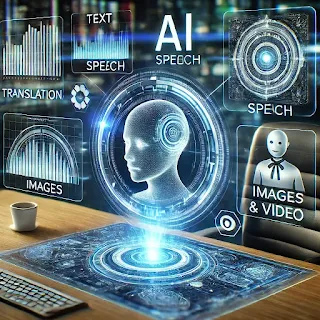How AI is Breaking Communication Barriers: The Future of Language Translation in 2025
- Get link
- X
- Other Apps
How AI is Breaking Communication
Barriers: The Future of Language Translation in 2025
Table of Contents
- Introduction
- Understanding
AI in Language Translation
- Current State
of AI Translation
- Impact Across
Sectors
- Challenges and
Limitations
- Future Trends
and Innovations
- Expert Opinions
and Predictions
- Multimedia and
Interactive Elements
- Conclusion
- References
Introduction
Artificial Intelligence (AI) is rapidly transforming the way we
communicate by breaking down language barriers. From healthcare and education
to business and tourism, AI-powered translation tools are reshaping global
communication. As we step into 2025, one of the most frequently asked questions
by Americans is: How is AI revolutionizing language translation?
In this article, we will explore how AI translation tools, such as Google
Translate, Microsoft Translator, and DeepL, are enhancing communication across
over 100 languages. We’ll also examine real-time translation in text, speech,
images, and video, discuss the benefits and challenges, and predict future
trends.
 |
A historical timeline showcasing the evolution of AI translation technologies from early rule-based methods to advanced neural machine translation |
Understanding AI in Language
Translation
Language translation involves converting text or speech from one language
to another while preserving meaning and cultural context. AI plays a
significant role in this transformation through technologies like Neural
Machine Translation (NMT) and Large Language Models (LLMs).
What is Neural Machine Translation
(NMT)?
NMT uses deep neural networks to analyze and understand language at a
much deeper level than previous rule-based methods. By processing entire
sentences as context units, NMT systems produce translations that are more
natural and context-aware.
Role of Large Language Models (LLMs)
Large Language Models, such as OpenAI's GPT series, are trained on
enormous datasets to understand language patterns and generate human-like text.
These models not only translate but can also provide context, detect nuances,
and adapt translations based on user feedback.
Multimodal Translation
One of the most exciting developments is multimodal translation—extending
beyond text. AI can now translate:
- Speech: Real-time
speech-to-speech translation enables seamless conversations.
- Images: Tools like
Google Lens can translate text within images instantly.
- Videos: AI can caption
and translate video content.
 |
Current State of AI Translation
As of 2025, AI translation technology is more advanced than ever. Leading
platforms have expanded their capabilities, offering real-time translation
across multiple modalities.
|
AI Translation Tool |
Supported Languages |
Key Features |
|
Google Translate |
100+ |
Text, speech, image translation |
|
Microsoft Translator |
60+ |
Business
integration, real-time speech |
|
DeepL |
26+ |
High
accuracy, professional-grade translations |
|
Amazon Translate |
100+ |
Enterprise
solutions, scalable API |
These tools are making global communication faster, more inclusive, and
more accessible.
Impact on Various Sectors
|
Sector |
AI Translation Impact |
|
Business |
Global expansion, cost reduction,
multilingual support |
|
Education |
Personalized
learning, inclusive materials |
|
Healthcare |
Improved doctor-patient
communication, multilingual medical records |
|
Tourism |
Real-time
translations for signs, menus, and conversations |
Challenges and Limitations
- Cultural
Nuances and Idioms: AI struggles with humor,
sarcasm, and idiomatic expressions.
- Support for
Less Common Languages: Limited training data can lead
to inaccuracies.
- Contextual
Understanding: AI may misinterpret complex or ambiguous sentences.
- Privacy
Concerns: Data collection raises security and ethical concerns.
- Technical
Limitations: Real-time processing demands high computational power.
Future Trends and Innovations
- Increased
Accuracy: AI models will continue improving contextual awareness.
- Multimodal
Translation: Integration with AR/VR for real-time translations.
- Expanded
Language Support: More languages, including
indigenous dialects.
- Wearable
Technology: AI-powered smart glasses and real-time subtitle generation.
- Ethical
Regulations: Stronger frameworks for bias mitigation and data privacy.
🎥 [Embedded Video:
The Future of AI Translation: Breaking Language Barriers] (Placed in
"Future Trends and Innovations")
Expert Opinions and Predictions
Industry leaders from Google, Microsoft, and DeepL emphasize ongoing
improvements in real-time AI translation. Analysts predict the AI translation
market will exceed $30 billion by 2025, driven by globalization and increased
cross-border communication.
Conclusion
AI is breaking communication barriers like never before, making global
communication seamless. As AI translation evolves, it will become more
context-aware, multimodal, and inclusive. However, ethical concerns and
technical challenges must be addressed to maximize its benefits. The future
promises a world where language is no longer a barrier but a bridge to greater
understanding.
References
- Get link
- X
- Other Apps




Comments
Post a Comment